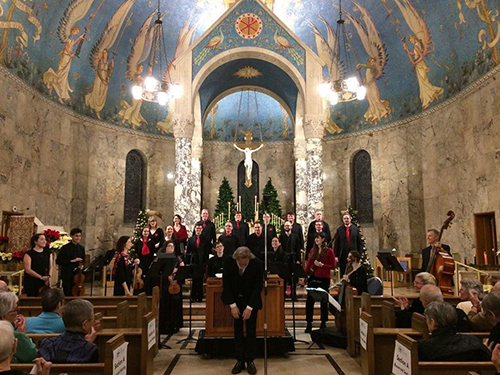by Timothy Robson

Guest conductor Eric Milnes led the ensembles from the keyboard of a small chamber organ. I heard the concert in its third performance on Sunday, December 23, at Our Lady of Peace Church in Cleveland. The church was packed, but its many stone surfaces made for an appropriately reverberant acoustic, even with a full house.
Charpentier’s Messe de Minuit incorporates tunes from popular French Christmas songs of the day (“Noëls”) into his setting of the five movements of the Ordinary of the Mass. In the 17th and 18th century, almost everyone in France knew these Noëls and would have recognized them even as Charpentier wove them into the musical texture. (As an organist, I’ve played many settings of the Noëls, so I’m familiar with the tunes and recognized them dressed up in Charpentier’s brilliant garb. But even those unfamiliar with the tunes could still delight in Charpentier’s music.) The moods of the five movements were varied, but tended toward joyous, sometimes even jaunty. There were striking moments of text-setting. For example, in the Nicene Creed, Charpentier repeats the words “Et Homo factus est” (“And was made man”) three times — the heart of the concept of Incarnation.
The performance was all at a very high level. Quire Cleveland’s diction (using Latin pronunciation as it would have been sung in France in the 17th century) and intonation were pristine. Les Délices’s playing was likewise stylish in its phrasing and tasteful ornamentation. The blend between ensembles was impeccable. It was hard to believe that these two groups don’t perform together regularly, such was their unity of style and performance.
The concert opened with Michel Corrette’s Noëls sur les instruments. Corrette (1707-1795) was a generation later than Charpentier, yet their style was similar, with lavish variations on the Christmas tunes and fluent ornamentation. Each of the settings had its own character: joyful, dance-like, a lullaby, a pastorale with a bass drone like a bagpipe. Les Délices captured the spirit of each setting, and oboists Debra Nagy and Kathryn Montoya showed their versatility in also playing recorders of several sizes.

The performance of this rarity was very fine in all regards, but special mention must go to tenor Nathan Dougherty and baritone Daniel Fridley. Dougherty sang a now-obsolete voice part found in French Baroque music, the hautcontre, a very high tenor who sings not in falsetto, but in true head voice to stratospheric heights. Here, the hautcontre served as the narrator, providing continuity among the various arias and choruses. Fridley brought a special lyric dignity to Consolare filia Sion (“Be comforted, daughter of Sion”).
Former Quire Cleveland director Ross Duffin contributed three unaccompanied settings of Noëls. Jay White led the performances while also singing with the ensemble. The arrangements were clearly modern and highly imaginative, but maintained the overall French Baroque tone of the songs. Une jeune pucelle tells the story of the Angel Gabriel’s appearance to Mary, ending with the Virgin’s great song of praise, “My soul magnifies the Lord.” Tous les bourgeois de Châtre is in a jaunty triple meter, portraying the citizens of Châtres and Montlhéry dancing and drinking in celebration of the angels appearing to the shepherds and their flocks. The end describes a young boy from Nevers who sang a thousand lovely airs combined with Alleluias to Joseph and Mary. Voici le jour solennel depicts the Magi’s interactions with Herod on their way to pay homage at Jesus’s crib. Duffin’s arrangements are worthy of more performances beyond those of Quire Cleveland, although the lengthy French texts might be intimidating to many choral groups.
If there could be any quibble at all with this concert, it was its generous length, over ninety minutes with no intermission. In a church filled with more 600 listeners, an intermission would have been difficult to manage. But having to sit for that long was far outweighed by the brilliant music-making of Les Délices and Quire Cleveland. We can hope that the success of this venture will encourage future collaboration.
Photos by Roberta Senatore from Quire’s Facebook page.
Published on ClevelandClassical.com January 2, 2019.
Click here for a printable copy of this article



